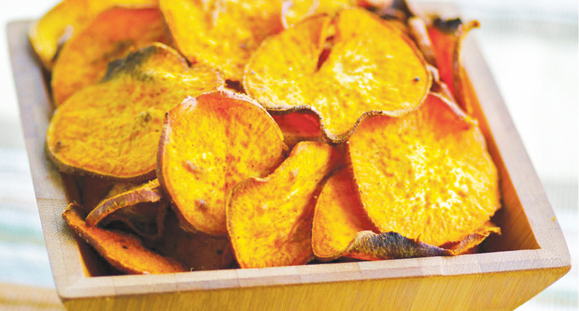Mama’s Punjabi Recipes: Pheetu (Vegetable Chips)
The word pheetu is an unusual one, even for Punjabis, as it is not in common usage. That’s because it is a Jhungi Punjabi word, which is only one of the over six main Punjabi dialects from West Punjab, which became part of West Pakistan in the Partition of 1947. The others are Lahori (for Lahore), ‘Pindi (for Rawalpindi), Multani and Peshawari. When you cross over to East Punjab (which is in India), there are at least another half-a-dozen Punjabi dialects, with the Delhi dialect being the sweetest (of course, I am biased).
Pheetu is the word from the Punjabi of Jhung, where many of my ancestors and relatives came from. Jhungi people are quite proud of their language as well as the heritage of the area; many Punjabi’s across the world can trace their families back to Jhung. There are certain words and phrases that can tell you that a person is of Jhungi descent.
So pheetu actually means “sliced chips” and the dish is a way to cook up some vegetables quickly, without having to go to the trouble of peeling or making a masala or curry. Yet, if you put in the right amount of spices and cook it over the right heat, this is a quick dish that can fill a stomach well. You can eat them with soft rotis as a side dish, with a daal or curry dish. Do not use haldi (turmeric) with this recipe.
And pheetu can be made with several vegetables that can be sliced, like aaloo (potatoes – a favorite of many), baingan (eggplant) or tauri (zucchini squash). Each of them has its own cooking time and texture and each comes out differently, even though the spices are about the same, so you should try them all out.
Ingredients :
2 large aaloo (potatoes – red or white, not baking type)
1/2 tbsp tael (olive oil or sunflower seed oil)
Spices (to taste): namak (salt), lal mirch (red pepper), garam masala, methi powder (fenugreek powder) optional.
Directions:
1. Wash the potatoes then dry them with a towel. There’s no need to peel them; just cut them in ¼ inch thick round slices. Wash the slices in water.
2. On a tava (flatplate) or in a large frying pan, warm up the oil over medium heat and place the slices on flat in a layer. Add a pinch of salt to taste, then cover and let cook for 2 minutes.
3. Uncover and then turn the slices over with a spatula, being careful not to break them. Cover and let cook for 5 minutes.
4. Take the cover off, sprinkle with red pepper and garam masala and then serve on a plate. For added taste, try sprinkling with methi powder.
5. If you want to make more, just use more potatoes and make another batch. Also try making this dish with round baingan (eggplant) or tauri (zucchini squash) in the same way.
6.This dish is best served as a side dish with roti (flour chappatis) in a typical Punjabi fashion.
MAMA’S TIP OF THE WEEK
ROAST JEERA (CUMIN SEED) & SAUNF (FENNEL SEED) FOR LONG SHELF LIFE
Most seeds, like jeera (cumin seed) and saunf (fenugreek seed) are often sold in bags and then people keep them in their pantries until they are needed. After many months, they may find that they have gone stale or are not as crisp as they were when they bought them.
In the old days, when we didn’t have refrigerators and everything when eaten fresh from the farm or bazaar, we would often just roast the jeera and saunf on a tava (flatplate) for a few minutes over low heat. This also creates a nice fragrance in the entire house and also extends the life of the seeds for a long time. You can then store them in bottles for many months.
Shakuntla Malhotra is a skilled cook of Punjabi dishes made in the old-fashioned style that she learnt as a young woman in her ancestral home in Lyallpur, India before it became part of Pakistan after the Partition in 1947. People have often admired her cooking for its simplicity and taste that comes with each mouthful. Even in her mid-eighties, she continues to cook daily and agreed to share some of her delectable Punjabi recipes.


